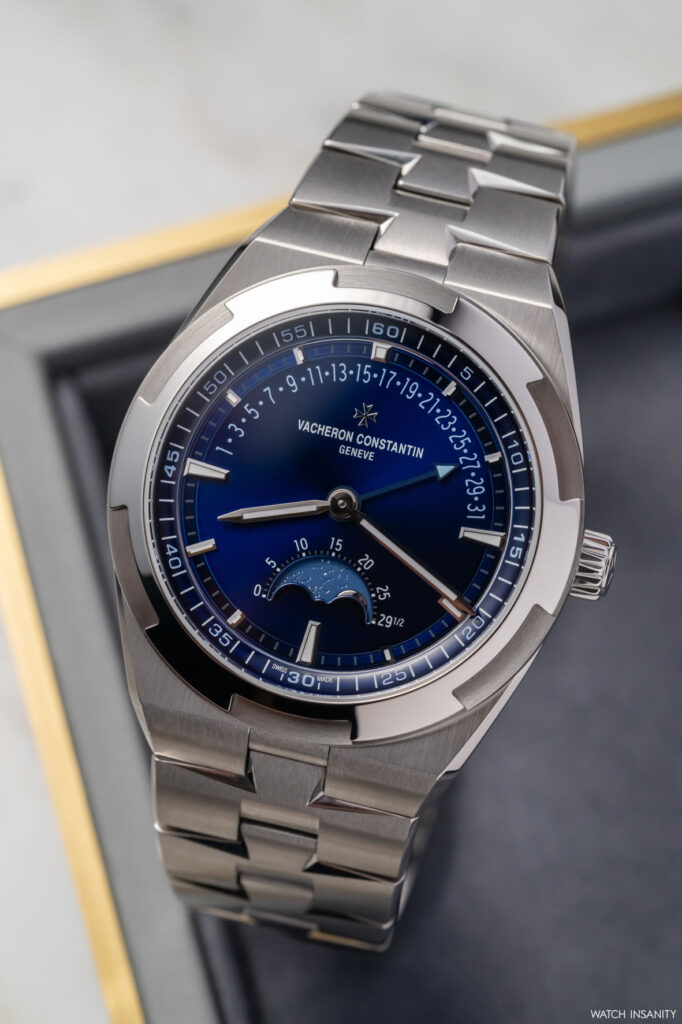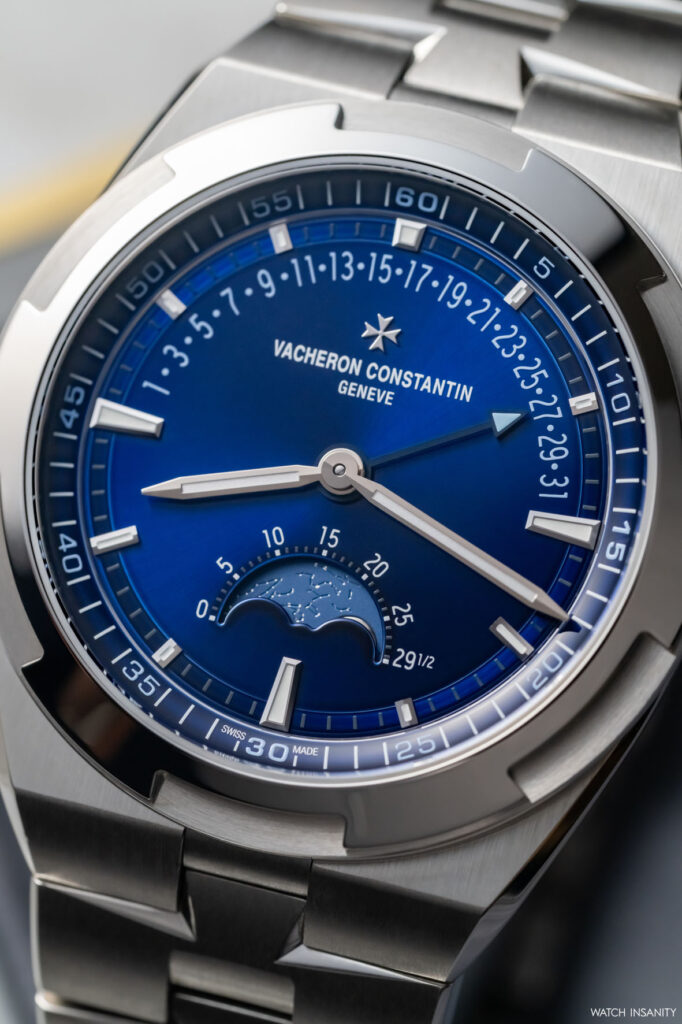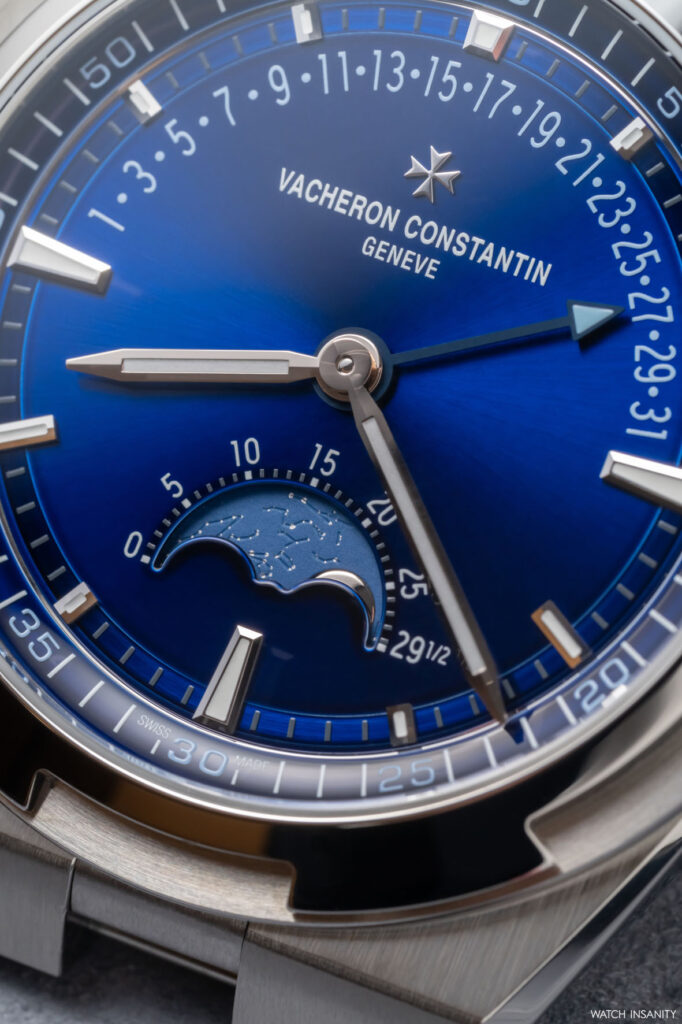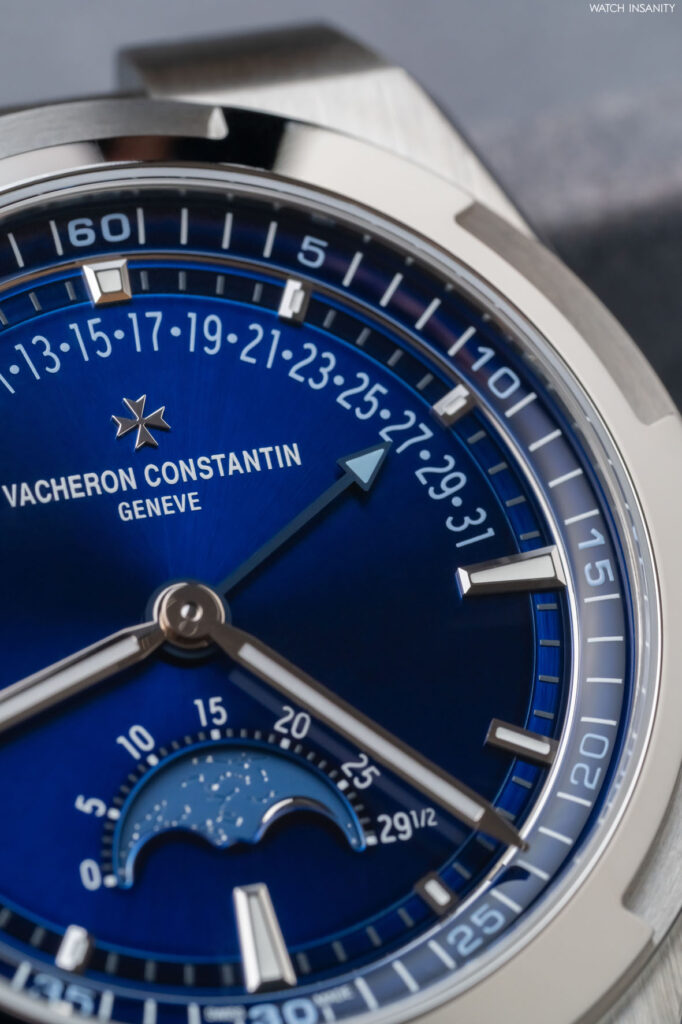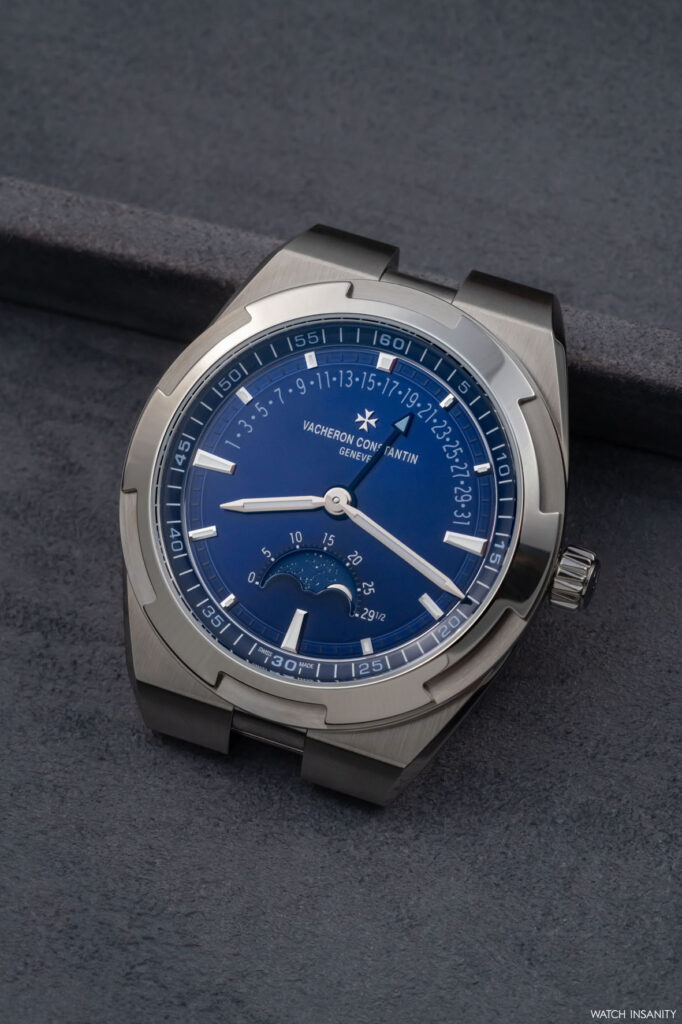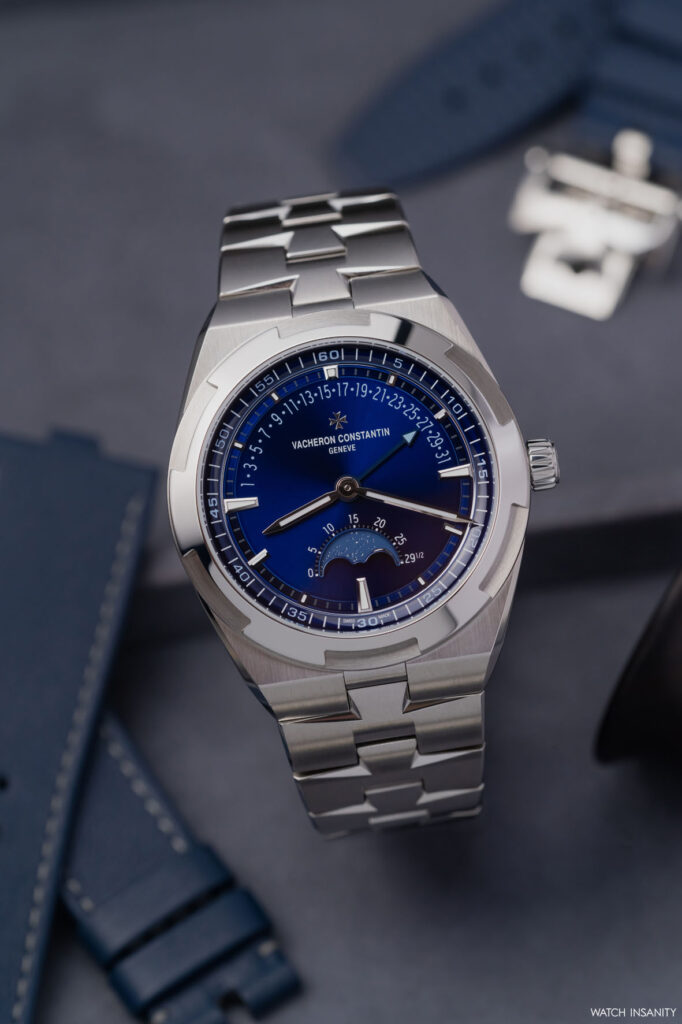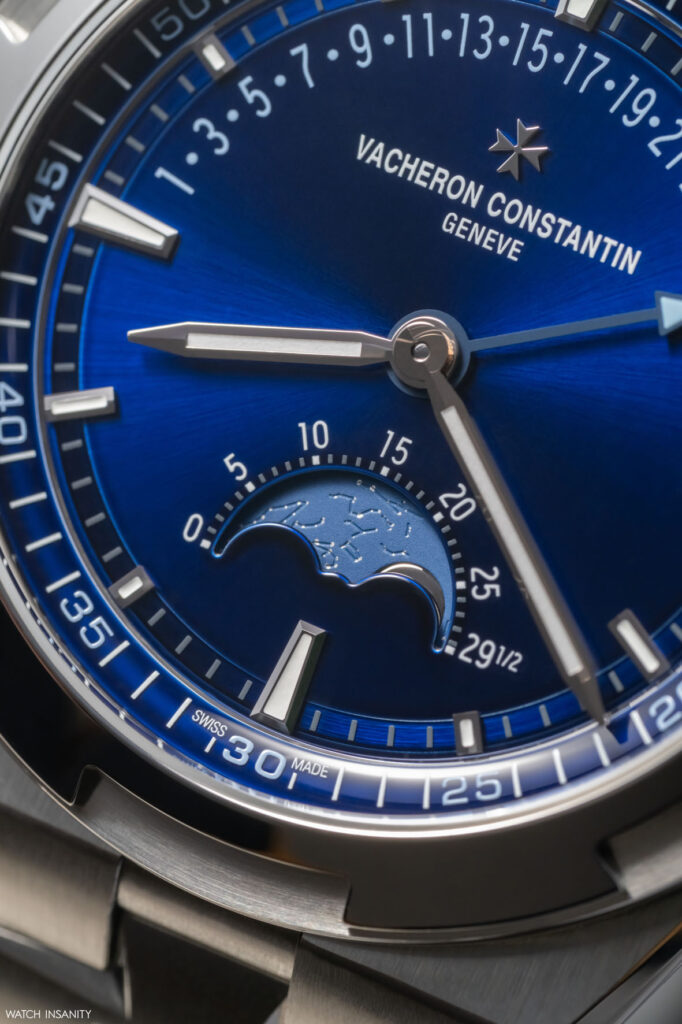Overseas moon phase retrograde date: tradition and sportiness for Vacheron Constantin
28 March 2024A short while ago, we wrote about the importance of the Overseas collection in Vacheron Constantin’s offering, recounting its origins and history, and lingering over one of its most recent creations: the 34.5 mm self-winding steel model with a sun-blue dial. A colour, this Overseas blue, that also dresses another fine reference in the line, the Overseas with moon phase and retrograde date. A watch worth writing about, and worth admiring in our exclusive photo shoot. Because it presents many of those traits that make Vacheron Constantin unique among haute-horlogerie brands.
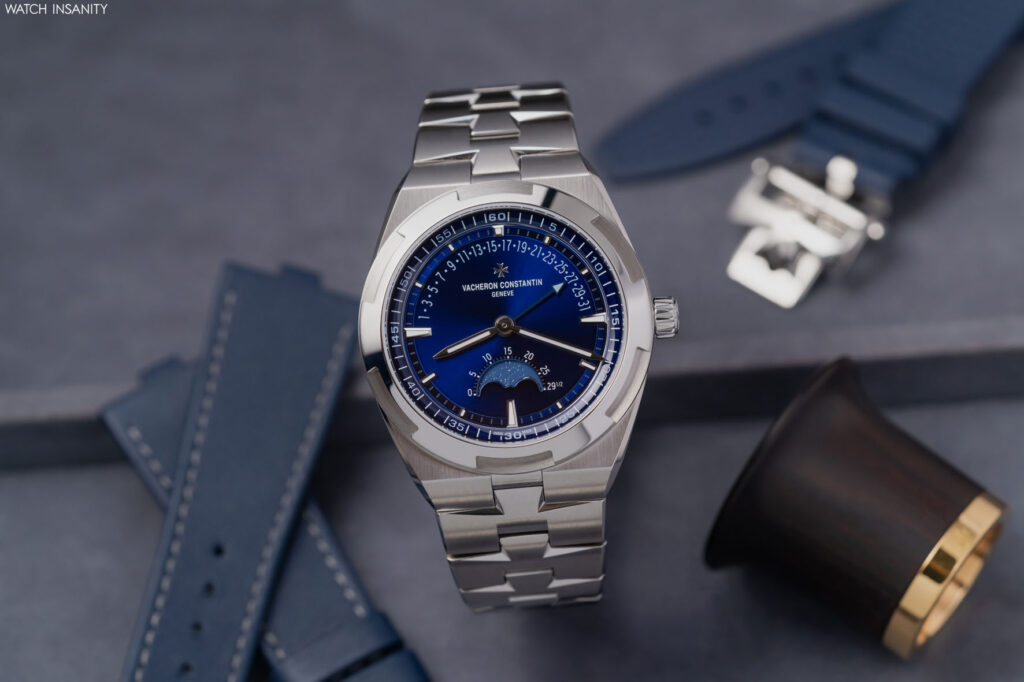
We won’t go over the history, technique and design behind the collection’s birth again. What deserves to be recounted about the Overseas with moon phase and retrograde date is the technical effort beneath the retrograde displays. A complication that doesn’t only relate to the date, but also to the minutes and seconds, for example, and in which Vacheron Constantin has excelled for centuries. Let’s see why.
VACHERON CONSTANTIN AND RETROGRADE INDICATIONS
Special indications, used in mechanical movements to decouple the functions on the dial from the gear train, raised watchmakers’ interest since the very beginnings of pocket and desk watchmaking. These were complications that included both jumping and retrograde displays.Some historical documents mention these alternative displays as early as the mid-18th century, in an astronomical pendulum clock with retrograde date attested in Germany.
As far as pocket watches are concerned, the ‘Journal Suisse d’horlogerie’ of 1906 described a model with a retrograde date and month from 1791 while, in the same decade, the Maison Lépine produced a watch with a retrograde hour hand in Paris.
Vacheron Constantin began designing pocket watches with jumping indications as early as the beginning of the 19th century (the first dating back to 1824) and developed timepieces with retrograde indications in the 20th century. Retrograde indications experienced an early heyday at Vacheron Constantin from the 1920s, when the company distinguished itself with a style that reflected the aesthetic principles of Art Deco. Then, from the mid-1930s, at a time when the watchmaking world was animated by a strong creative impulse, this type of indication began to appear on the Maison’s wristwatch references.
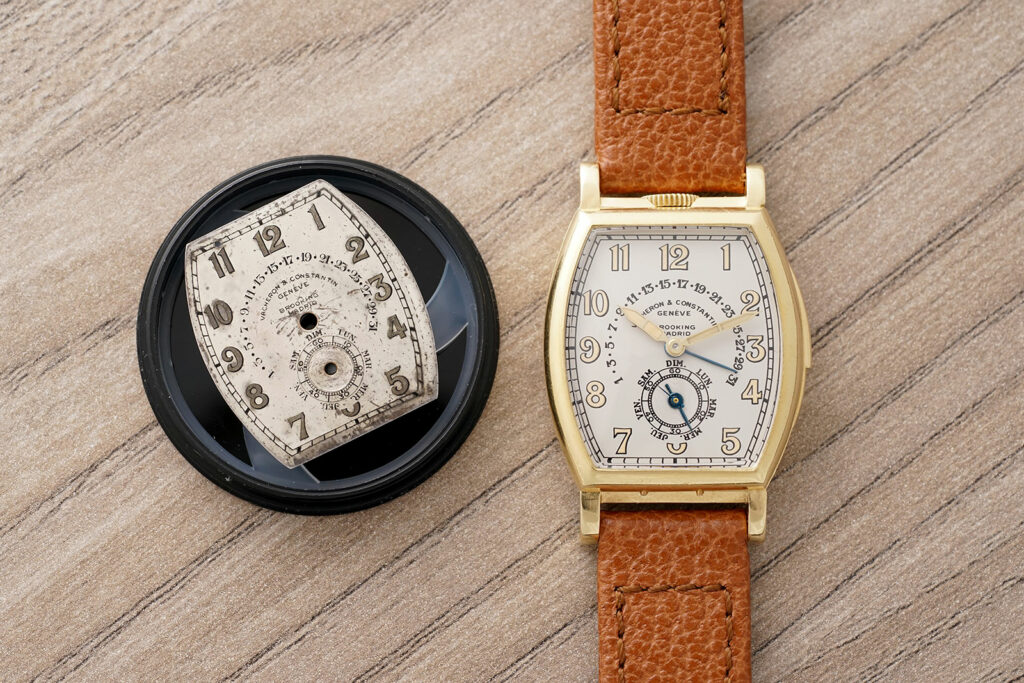
Pieces such as the 1930 ‘Bras en l’Air’ pocket watch with a double retrograde display were born: by touching the push-button at 10 o’clock, the arms of an engraved and enamelled gold Chinese wizard rose to indicate the hours and minutes. Or like the so-called ‘Don Pancho’, created for a Spanish customer in 1939 after four years of development: it combined minute repeater, calendar display and retrograde hand. Auctioned in 2019, it achieved the second highest bid ever for a Vacheron Constantin wristwatch.
After a long absence, this complication was reborn with the success of the mechanical wristwatch in the 1990s. From a technical point of view, the dial became more complex, with bi-retrograde, tri-retrograde and even more structured indications, and these complications once again became a technical and aesthetic signature of the Maison, present in several collections including, not least, the Overseas.
RETROGRADE INDICATIONS: HOW THEY WORK
A retrograde indication is characterised by the fact that the indicator does not complete a full revolution of the dial, but returns to the starting point and starts moving forward again after covering the entire measuring segment. Typically, it is a hand moving along a circle’s arc. Although from its look it may seem like a trivial complication, it is instead a mechanism that requires extreme precision.
The retrograde hand,in fact, does not couple directly with the wheel dedicated to it, as is the case on traditional watches, but is positioned on an off-centre axis, which in turn is equipped with a spring and pinion. This wheel is surmounted by a spiral cam with notches. Between the two components is a lever which, on the one side, has a beak that slides along the cam, and on the other a rake that meshes with the seconds pinion. The rotation of the gear drives the retrograde hand forward through this lever, which puts tension on the spring.
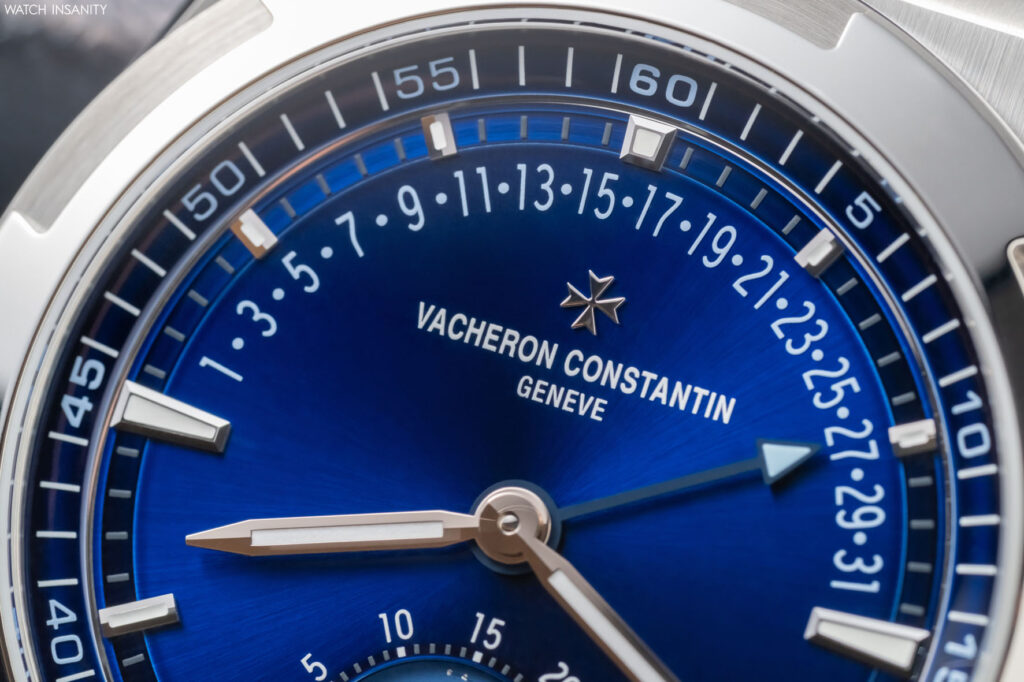
When the beak drops into the cam notch at the end of its run, the lever instantly returns the seconds hand to zero with the help of the spring connected to the pinion. Depending on the components, the indicator’s return to its initial position can occur at speeds as fast as 60 km/h.As can easily be understood, this type of mechanism requires rigorous construction, especially in terms of resistance to shocks and wear. Springs, hands and wheels can wear out or even break when subjected to blows of this magnitude, which is why Vacheron Constantin takes particular care in the engineering of its components and the choice of materials used to manufacture them.
PRECISION MOON PHASE ON THE OVERSEAS
As written, therefore, for the first time the Overseas collection is also home to a retrograde display – a complication that was hitherto reserved for the Patrimony line and a haute-horlogerie piece from the Traditionnelle collection. And it does so on a new model that retains the collection’s classic features: a hexagonal bezel evoking the Maltese cross, a fluted crown, polished and satin finishes, a translucent lacquered dial, and luminescent hour markers and hands. It is the Overseas with moon phase and retrograde date.
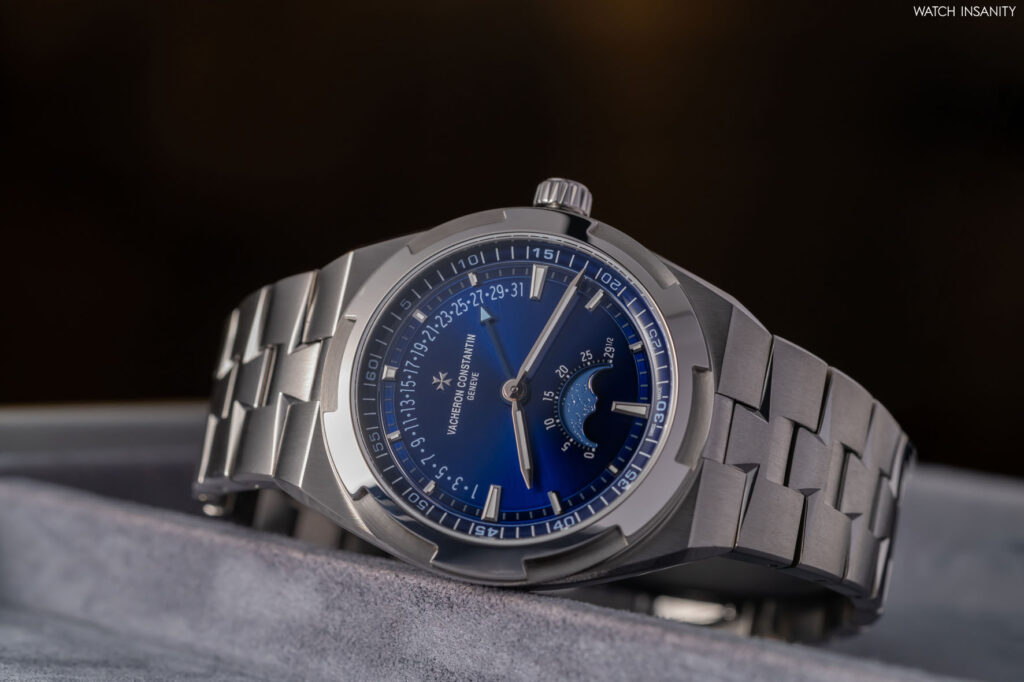
As is evident from its name, this watch associates the retrograde date with precision moon phase, also a ‘first’ for the Overseas collection, and a complication that requires unique expertise to produce. The expression ‘precision moon phase’ is not used by chance. It is normally said that a lunar orbit around the Earth lasts 29.5 days; actually, its exact duration is 29.53059 days. On the Overseas precision moon phase display with moon phase and retrograde date, this discrepancy is corrected using a disc with two moons, driven by a wheel with 135 mechanical teeth.
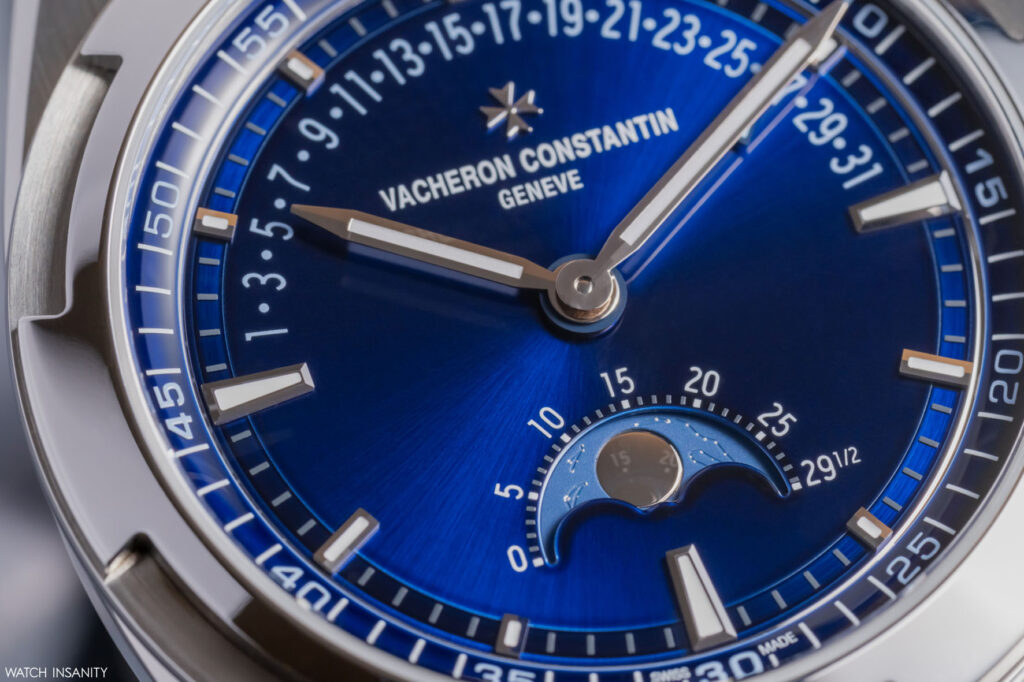
If only one moon were used, 29.5 teeth would be needed to make it complete the revolution cycle. Which is mechanically not feasible. The two moons are placed diametrically to each other and both are only visible through a small window, to create the illusion of a moon advancing as the days go by until it reaches full moon, and then returning to a new moon and resuming its course. Thus, on the Vacheron Constantin Overseas with moon phase and retrograde date, the precision moon phase is linked to the date, and our satellite appears on it with a fluctuation between the mechanism and the true lunar cycle of just one day in 122 years.
BLUE OVERSEAS: VACHERON CONSTANTIN’S SIGNATURE
Well, for its Overseas with moon phase and retrograde date, Vacheron Constantin has managed to fit all these indications on the dial without sacrificing their legibility or distorting the sporty soul of the collection. A risk that was just around the corner, precisely because the retrograde display, typical of the more elegant collections, could have shifted the balance of the watch towards a more classic segment. That did not happen.
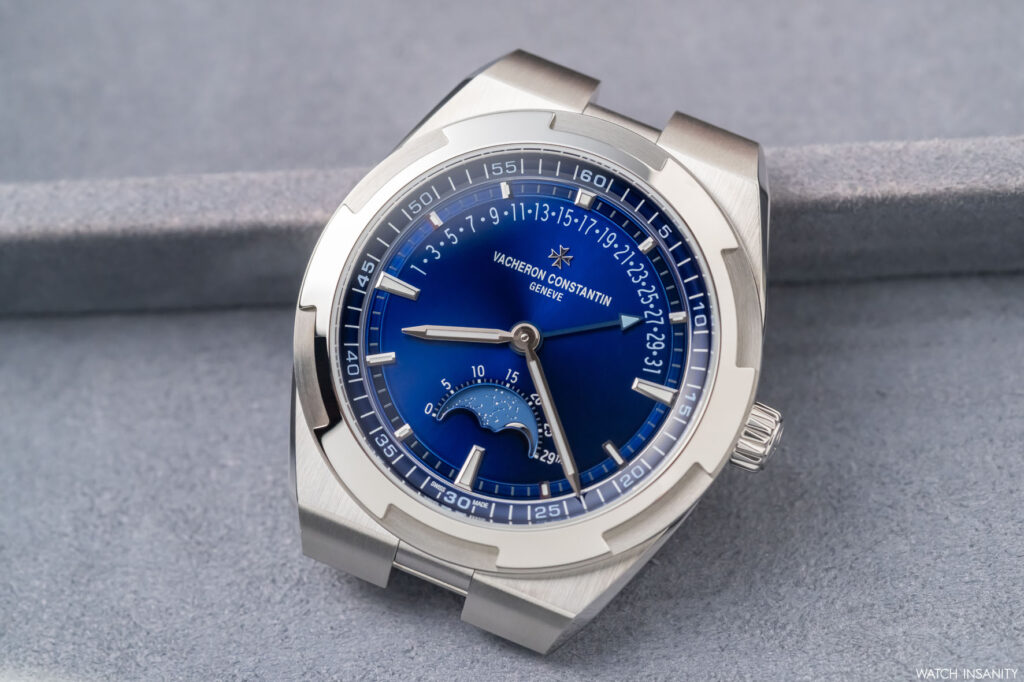
The dial demonstrates it first and foremost. Its translucent lacquered blue, typical of the Overseas collection, is the first element that strikes and captivates the eye. It has the merit, among other things, of making the information legible – information which Vacheron Constantin has made as user-friendly as possible by placing it on opposite ends of the dial. The retrograde date is placed on an arc from 9 o’clock to 3 o’clock; the moon phase window is positioned just above 6 o’clock.
An interesting detail in style is the hand indicating the retrograde date: it is blue with a blue tip and, together with the dark blue background of the moon phases, contributes to the chromatic homogeneity ofthe entire dial. The applied hour markers and hour and minute hands are in white gold, all highlighted with blue Super-LumiNova to keep the time visible in both bright and dim light conditions.
THE 2460 R31L/2 CALIBRE
As we wrote above, handling retrograde displays requires technical virtuosity at the movement level that few brands can master. Vacheron Constantin’s Overseas with moon phase and retrograde date is driven by the self-winding calibre 2460 R31L/2, a movement with 11½ lines, i.e. 27.2 mm in diameter by 5.4 mm thick. It is developed on the basis of the 2460 R31L, which is housed in the Patrimony collection’s retrogrades.
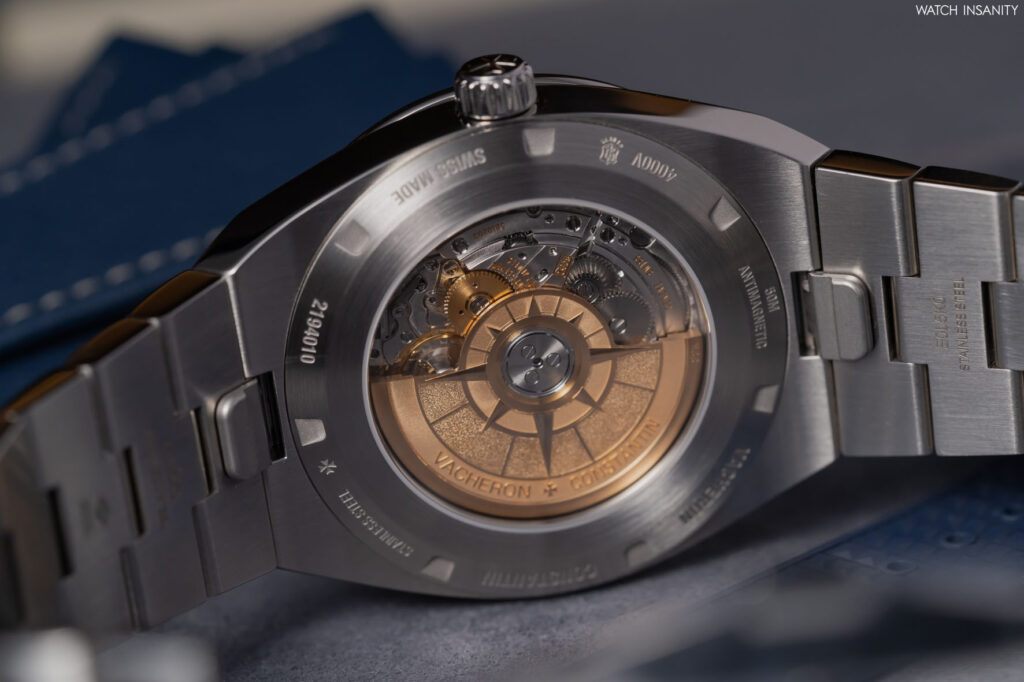
This Vacheron Constantin manufacture calibre, finished with 275 components, offers a 40-hour power reserve and drives the hour and minute hands, precision moon phase display and retrograde date. With this movement, the Maison has succeeded in creating an easily adjustable mechanism. The crown offers simple and easy access to all three functions of the watch. In the first position, it winds the watch. Once pulled out to the second position, it can be turned clockwise to adjust the date or counter-clockwise to adjust the moon phase, while the third and final position controls the time setting.
A transparent sapphire crystal on the case back reveals the 2460 R31L/2 movement and the 22-carat gold oscillating weight, adorned with the characteristic compass rose motif typical of this Vacheron Constantin collection. Unfortunately, the bridges and the main plate conceal the complex system of levers that governs the retrograde date. However, since this is the Overseas line, and therefore one with a sporty rather than elegant DNA, it is perhaps better this way: it loses a little charm, but an overall impression of robustness and reliability is gained.
ALL THE OVERSEAS’ CODES
Without, however, sacrificing aesthetics altogether. Which, in the case of this timepiece, speaks through a steel case 41 mm in diameter and 10.48 mm thick. Interesting numbers, because the Maison has succeeded in ensuring optimal legibility within a diameter with ‘modern’ dimensions, combining the latter with a super wearable thickness, despite the complications with which the movement is equipped.
The structure of the case is the one we have come to know so well in the Overseas collection, with its slightly tonneau shape crowned by the polished six-notched bezel reminiscent of the shape of the Maltese cross. A dazzling, almost mirror-like polish balances the satin finish characterising almost the entire steel case and bracelet with the half Maltese cross motif.
Not an insignificant detail: the fact that Vacheron Constantin made all the watch’s functions adjustable via the crown, thus avoiding the presence of pushers or correctors on the side of the case. On the one hand, this absence benefits the overall aesthetics of the Overseas with its moon phase and retrograde date; on the other, it does not introduce any weak points that could compromise the water-resistance of the case, here guaranteed up to 5 bar. Let’s not forget that the Overseas is a timepiece designed for active life and exploration, which is why water resistance is a fundamental requirement. Let’s say that 5 bar, for the collection’s vocation, is the minimum expected; 10 would have been the optimum.
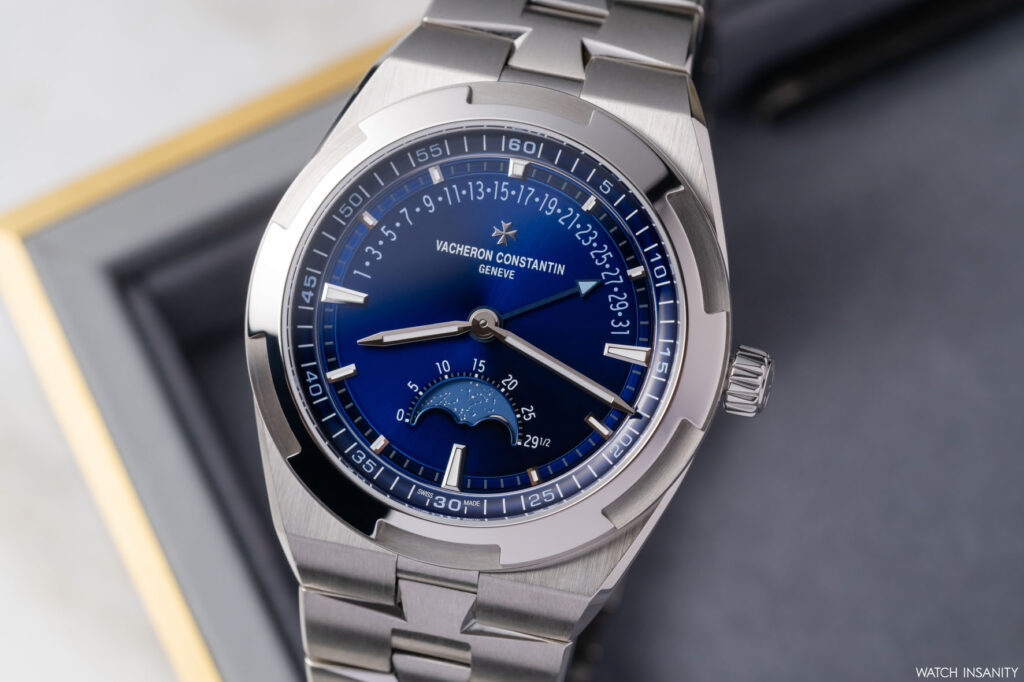
As for the Overseas automatic with its 34.5 mm steel case, on this retrograde the steel bracelet can be replaced with either a leather or a rubber strap, both blue and both with a folding clasp, like the bracelet. Tool-free replacement is facilitated by the button located on the inside of the clasp, halfway along the lug: when pressed, the strap or bracelet is very easily released.
The fact that it took three years of research and development to integrate the traditional functions and complications of the retrograde date and precision moon phase into the Overseas collection gives an idea of how much Vacheron Constantin cares about the evolution of this line. With this model, available exclusively at the brand’s boutiques for €48,700, the Maison has put technology at the service of style and vice versa, reminding us that even stylistic features typically its own, such as retrograde displays, can be reinvented and modernised. An ability that very few brands have.
By Davide Passoni

